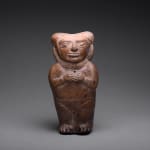Chimu Rattle in the Form of a Standing Woman, 800 CE - 1200 CE
Terracotta
height 18.1 cm
height 7 1/8 in
height 7 1/8 in
PF.1453
Further images
The Chimu culture arose around 800 A.D. and flourished until the Incan conquest about six hundred years later. Their civilization was centered at their capital Chan Chan, about 300 miles...
The Chimu culture arose around 800 A.D. and flourished until the Incan conquest about six hundred years later. Their civilization was centered at their capital Chan Chan, about 300 miles north of Lima, literally meaning “Sun Sun,” the largest Pre-Columbian city in Peru estimated to contain almost one hundred thousand citizens. The Chimu believed the sea, which they called “Ni,” was the origin of life, a theory also proposed by modern science and evolution. Thanks to their sea-faring skills, the Chimu were able to survive, nestled in between the desert and the sea. The sea was everything to them: an endless supply of food and the source of inspiration for their most imaginative myths, legends, and artwork. Agriculture was also vital, and the Chimu drew up a vast number of irrigation works demonstrating immense engineering skill, some of which are still in use today. Today, aside from the astounding mud ruins of Chan Chan remarkably well preserved in the heat of the desert, the Chimú are perhaps best known for their distinctive black glazed pottery influenced by their predecessors: the Moche.
Depicting a woman in an attitude of reverent prayer, this splendid rattle was once shaken at a religious ceremony. The prominent sexuality of the figure suggests that the rites concerned fertility. As we shake the rattle ourselves, we can imagine a temple courtyard filled with worshippers, each making noise to attract the attention of the heavens. The person who held this instrument long ago was no doubt a woman of similar appearance, perhaps petitioning a goddess for children. Hearing the rhythmic music today, we are transported to a distant world.
Depicting a woman in an attitude of reverent prayer, this splendid rattle was once shaken at a religious ceremony. The prominent sexuality of the figure suggests that the rites concerned fertility. As we shake the rattle ourselves, we can imagine a temple courtyard filled with worshippers, each making noise to attract the attention of the heavens. The person who held this instrument long ago was no doubt a woman of similar appearance, perhaps petitioning a goddess for children. Hearing the rhythmic music today, we are transported to a distant world.
Literature
V5







